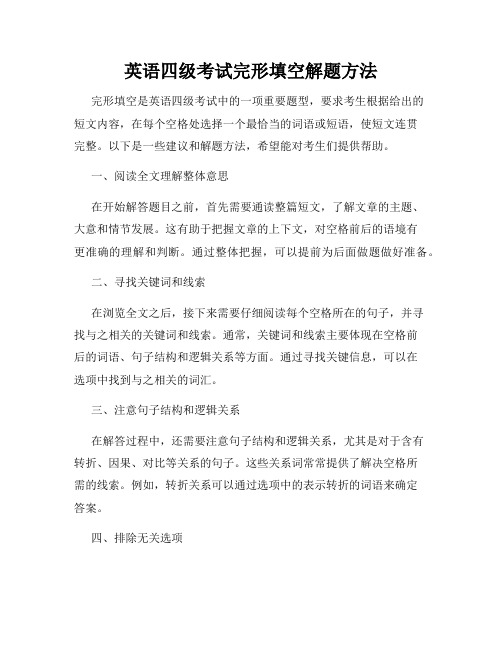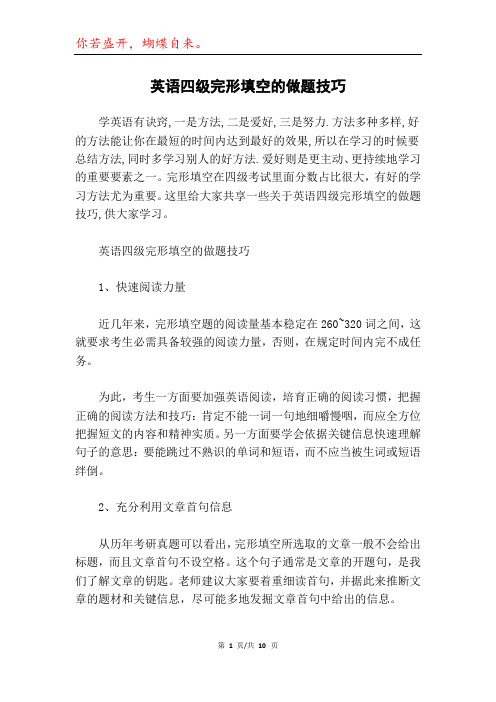2021年大学英语四级完形填空备考技巧
英语四级考试完形填空解题方法

英语四级考试完形填空解题方法完形填空是英语四级考试中的一项重要题型,要求考生根据给出的短文内容,在每个空格处选择一个最恰当的词语或短语,使短文连贯完整。
以下是一些建议和解题方法,希望能对考生们提供帮助。
一、阅读全文理解整体意思在开始解答题目之前,首先需要通读整篇短文,了解文章的主题、大意和情节发展。
这有助于把握文章的上下文,对空格前后的语境有更准确的理解和判断。
通过整体把握,可以提前为后面做题做好准备。
二、寻找关键词和线索在浏览全文之后,接下来需要仔细阅读每个空格所在的句子,并寻找与之相关的关键词和线索。
通常,关键词和线索主要体现在空格前后的词语、句子结构和逻辑关系等方面。
通过寻找关键信息,可以在选项中找到与之相关的词汇。
三、注意句子结构和逻辑关系在解答过程中,还需要注意句子结构和逻辑关系,尤其是对于含有转折、因果、对比等关系的句子。
这些关系词常常提供了解决空格所需的线索。
例如,转折关系可以通过选项中的表示转折的词语来确定答案。
四、排除无关选项遇到难题时,可以通过排除法逐一排除明显无关的选项。
首先要明确空格前后句子的要义,并仔细分析每个选项的意思,判断其是否与上下文逻辑一致,是否能确保文章连贯。
有时候,即使有些选项在语法上是正确的,但与文章的内容和逻辑不相符,也需要排除。
五、上下文逻辑和词义猜测在遇到词义不明的词语时,可以根据上下文逻辑进行推测。
通过理解空格前后句子的意思和语境,可以对词义进行合理的猜测,从而选择正确的选项。
六、注意时间管理在考试中,时间管理非常重要。
因此,解题过程中要迅速但准确地作出选择。
如果某个空格较难,可以先跳过,解答其他题目,然后再返回解答。
综上所述,要想在英语四级考试中取得好成绩,熟悉和掌握完形填空解题方法至关重要。
通过阅读全文、寻找关键词和线索、注意句子结构和逻辑关系、排除无关选项、上下文逻辑和词义猜测以及合理的时间管理,可以提高解答问题的准确性和速度。
希望每位考生能够根据以上方法进行备考,并在考试中取得优异的成绩。
大学英语四级完形填空做题经验总结

大学英语四级完形填空做题经验总结【导语】以下是作者帮大家整理的大学英语四级完形填空做题经验总结(共14篇),供大家参考借鉴,希望可以帮助到您。
篇1:大学英语四级完形填空做题经验总结1.细读首句或首段,启示全文近几年的高考完形填空大多不在首句中设空,这样首句就成为一个很好的提示句。
它往往是了解文章的一个窗口,由此可判断文章体裁、推测文章大意、揭示故事发生的人物、时间、地点等方面的信息,这对我们理解全文有着重要的启示作用。
2.通读全文,正确理解文意这是做好完形填空的先决条件。
花上3分钟的时间,快速浏览全文,把握文章主题。
有些同学想省时间,看一点做一点,缺乏全局观念,有时甚至一步选错步步错,而且先入为主的东西一旦在头脑中形成概念是不易被纠正的。
快速阅读全文,了解文章的大意,注意语境和有关提示,正确地分析、归纳、概括出文章的主旨,千万不要急于选择答案。
3.细读短文,联系上下文,通篇考虑在了解文章大意的基础上,要按文章的先后顺序,对每道题所给选项的确切含义进行分析比较,并考虑其对整体语境的影响,运用逻辑思维推理的方式进行答题。
切不可自行断意,顾此失彼。
另外还要注意试题的难易度,应暂时绕开那些疑难问题,先做最有把握的题目。
4.利用好句子之间的逻辑关系完形填空题所选用的文章的上下文之间往往有较强的逻辑关系,这些逻辑关系主要包括并列、原因、结果、让步、转折、补充、目的、条件等,且这些逻辑关系是依靠不同的连接词来表达的,比如but,for,and,or,while,so,theref# 篇2:大学英语四级完形填空做题技巧1.充分利用首句信息完形填空题首句往往不设空,往往是全文的关键句,或者称为主导句,要充分利用完形填空题首句的提示作用,利用它为解题找到一个突破口,从而展开思维。
2.多角度的逻辑推理完形填空题的解题过程首先是一个阅读的过程,必须把握作者的思路,通过联想、推测等方法,多换角度去思考问题,使自己的思维模式与作者的思维模式相吻合。
大学英语四级完形填空答题技巧及复习计划

大学英语四级完形填空答题技巧及复习计划(实用版)编制人:__________________审核人:__________________审批人:__________________编制单位:__________________编制时间:____年____月____日序言下载提示:该文档是本店铺精心编制而成的,希望大家下载后,能够帮助大家解决实际问题。
文档下载后可定制修改,请根据实际需要进行调整和使用,谢谢!并且,本店铺为大家提供各种类型的实用范文,如学习资料、英语资料、学生作文、教学资源、求职资料、创业资料、工作范文、条据文书、合同协议、其他范文等等,想了解不同范文格式和写法,敬请关注!Download tips: This document is carefully compiled by this editor. I hope that after you download it, it can help you solve practical problems. The document can be customized and modified after downloading, please adjust and use it according to actual needs, thank you!In addition, this shop provides various types of practical sample essays, such as learning materials, English materials, student essays, teaching resources, job search materials, entrepreneurial materials, work examples, documents, contracts, agreements, other essays, etc. Please pay attention to the different formats and writing methods of the model essay!大学英语四级完形填空答题技巧及复习计划学英语有诀窍,一是方法,二是兴趣,三是努力.方法多种多样,好的方法能让你在最短的时间内达到最好的效果,所以在学习的时候要总结方法,同时多学习别人的好方法。
2021年大学英语四级考试完形填空技巧

大学英语四级考试完形填空技巧总体说来,大学英语四级考试完形填空所测试内容大体分为4类:1)语境词汇题;2)固定搭配题;3)语法构造题;4)逻辑推理题。
在大学英语四级考试完形填空中,词汇辨义题占大多数,普通都占30%,固定搭配与语法构造普通都各占20%-25%,逻辑推理题占20%。
大学英语四级考试完形填空命题思想是将词汇用法作为重点,以篇章理解为基本,考核学生语法知识和对词汇运用能力。
依照这一命题思想,咱们可以有针对性地、比较系统地对考查试题类型进行分类,依照各种题型不同特点应用不同答题技巧和办法。
1、语境词汇题大学英语四级考试完形填空对词汇考查在很大限度上与上下文语境关于,也就是填入哪个单词要依赖于试题上文或下文,从已知信息中推论出未知信息,这是大学英语四级考试完形填空考查重点和方向,同步要注意填入单词和周边单词语义搭配问题。
为了达到文章衔接和连贯目,文章中词汇会通过不同方式复现出来。
词汇复现关系指是某一词以原词、同义词、近义词、上义词、下义词、概括词或其她形式重复出当前语篇中,语篇中句子通过这种复现关系达到了互相衔接。
词汇复现关系又可分为原词复现、同义词或近义词复现、上下义词复现和概括词复现四类。
咱们可以运用词汇在文章中复现关系来解答完形填空试题。
1)原词复现原词复现是指相似单词在原文中重复浮现,达到文章衔接目,咱们可以运用这种衔接办法找到要填入单词在原文中同现词,也就找到了试题答案。
Wise buying is a positive way in which you can make your money go further. The 67 go about purchasing an article or a service can actually save you money or can add to the cost。
(.12)67.A) formal B) way C) method D) fashion【解析】试题所在句子含义是“购买物品或服务事实上会让你省钱或者增长成本”。
英语四级完型填空解题的精准技巧

英语四级完型填空解题的精准技巧完型填空是英语四级考试中的重点题型之一,它要求考生根据提供的上下文语境,选择最合适的单词或短语来填写空白处,从而完整地表达出一篇意思连贯、逻辑严密的短文。
为了在这一题型上取得更好的成绩,以下是一些帮助你掌握完型填空解题技巧的建议。
1. 阅读全文理解大意:在开始填写空白前,先通读整篇短文,了解大意和主题。
通过全文理解,可以更好地把握文章脉络和上下文,有助于准确填写空白。
2. 预测并选择合适的选项:在阅读短文时,尝试预测即将出现的单词或短语,填写空白时可与预测结果进行比较。
根据上下文的语法规则和逻辑关系,选出最合适的选项填入空白。
3. 注意上下文的逻辑连接:空白处前后的句子之间往往存在一定的逻辑关系,如因果关系、转折关系、并列关系等。
通过分析上下文的逻辑连接词汇(如however, therefore, for example等),可以更好地推测空白处应填的内容。
4. 注意动词的时态和形式:根据句子的时态和语境,选择相应的动词时态和形式填入空白。
通常,上下文的动词时态和形式是保持一致的。
5. 上下文的词汇提示:上下文中的其他单词和短语可以为填空提供词汇提示。
注意上下文中的近义词、反义词等,以帮助准确选择填写选项。
6. 语法和语篇逻辑的知识:熟悉一些常见的语法规则和语篇逻辑关系,有助于更好地解答完型填空题。
例如,掌握名词、动词、形容词、副词等词类的基本用法和搭配,了解主谓一致、动词时态、冠词用法等。
7. 注意选项间的逻辑关系:在选择填入选项之前,仔细阅读选项并注意其与上下文的逻辑关系。
有时,前后两个选项可能形成递进、转折或并列关系,正确的选项可以通过这些逻辑关系推断出来。
8. 多做练习题提高技巧:通过多做一些完型填空的练习题,有助于熟悉题型和提高解题技巧。
可以选择一些模拟试题或历年真题,并进行反复练习和总结。
综上所述,完型填空题在英语四级考试中是一个重要的考察项目。
通过了解文章主题、预测选项、分析上下文逻辑、注意语法和词汇,以及多做练习,可以提高解答这类题目的准确性和速度。
2021年12月四级完形填空解题策略及高分秘籍

2021年12月四级完形填空解题策略及高分秘籍完形填空题解题三种策略1. 要认真阅读原文。
?2. 注意句与句,段与段之间的内在联系,以免前后“撞车”。
?3. 短语词组搭配。
例如:?When television first began to expand, very few of the people who had become famous as radio commentators were able to be effective on TV. Some of the difficulties they experienced when they were trying to ?__1__? themselves to the new medium were technical. When working on radio, for example, they had become ?__2__? to seeing on the behalf of the listener. This ?__3__? of seeing for others means that the commentator has to be very good at talking, ...1. A. turn B. adapt C. alter D. modify?2. A. experienced B. determined C. established D. accustomed\=3. A. efficiency B. technology C. art D. perfermance?在第 1题中,adapt动词常与“to”搭配,表示“适应”,因此,技巧之一要注意动词或词组的搭配。
第2题中,也是习惯搭配高分秘籍一、通读全文,了解文章大意这是做完形填空的第一步,以快速阅读的方式浏览全文,了解文章大意,抓住主题和关键词,为解题做好准备。
英语四级完形填空的做题技巧

英语四级完形填空的做题技巧学英语有诀窍,一是方法,二是爱好,三是努力.方法多种多样,好的方法能让你在最短的时间内达到最好的效果,所以在学习的时候要总结方法,同时多学习别人的好方法.爱好则是更主动、更持续地学习的重要要素之一。
完形填空在四级考试里面分数占比很大,有好的学习方法尤为重要。
这里给大家共享一些关于英语四级完形填空的做题技巧,供大家学习。
英语四级完形填空的做题技巧1、快速阅读力量近几年来,完形填空题的阅读量基本稳定在260~320词之间,这就要求考生必需具备较强的阅读力量,否则,在规定时间内完不成任务。
为此,考生一方面要加强英语阅读,培育正确的阅读习惯,把握正确的阅读方法和技巧:肯定不能一词一句地细嚼慢咽,而应全方位把握短文的内容和精神实质。
另一方面要学会依据关键信息快速理解句子的意思:要能跳过不熟识的单词和短语,而不应当被生词或短语绊倒。
2、充分利用文章首句信息从历年考研真题可以看出,完形填空所选取的文章一般不会给出标题,而且文章首句不设空格。
这个句子通常是文章的开题句,是我们了解文章的钥匙。
老师建议大家要着重细读首句,并据此来推断文章的题材和关键信息,尽可能多地发掘文章首句中给出的信息。
3、留意词汇和词组的复现同现和复现是词汇的连接手段。
完形填空所给出的文章往往有明确的主线,会使用一些关键词围绕主线贯穿全文。
这些关键词可能会原封不动地重复消失,也可能会以其他形式消失例犹如义词、近义词、上义词等。
我们可以依据文章的关键词和文章的导一直解答一下题目,例如,假如推断出一个空格是上下文关键词的复现,那么我们只要从选项中选出与关键词意义相同的表达即可。
4、留意利用上下文整篇文章是个有机整体,所以依据上下文找出信息点是做好完型填空的关键所在。
依据历年考研英语真题,我们可以看到考研英语完型填空中有一多半的题目考查的是语义连接,只有借助于语境的启示和限定才能做出正确地选择。
这个时候,我们不能单纯的只看空格所在的句子,而要看其上下文。
(英语四级完形填空)英语四级题完形填空技巧

英语四级题完形填空技巧根据四级考试大纲,完型填空总分值占710分的10%。
其主要形式是在一篇约300词的文章中留出20个空白,要求考生从每题给出的4个选项中选出最正确答案,使补全后的文章意思通顺、前后连贯、结构完整。
所以完形填空在四级考试里面相当重要。
以下是我为大家整理的英语四级题完形填空技巧,感谢您的欣赏。
英语四级题完形填空技巧1.利用动词词组中的介词或副词确定正确选项如果我们认识某一词组,可根据自己的判断毫不犹豫地选择你认为是正确的选项。
如果不认识或拿不准它们的意义,我们可以根据动词后边的介词或副词进行推导。
2. 利用固定搭配或习惯用语四级词汇题目涉及对各种短语、固定词组和惯用语的测试,其所占的比例相当大。
测试范围包括动词短语、动词与其他词语构成的习语、介词短语、形容词短语等。
这类词组主要是习惯性和固定搭配用法,不能主观臆测,也不能随意创造,只能靠死记硬背。
3. 根据邻近原那么,利用词语意义的互相联系,确定选择的依据。
(1)选项为名词时,其前后的名词为选择的依据。
(2)选项为动词、动词词组(包括动名词、动词的分词形式)时,其前后的动词、名词、介词为选择依据。
(3)选项为形容词时,可以其前后出现的名词、动词、副词、介词为依据。
(4)选项为副词时,其前后出现的动词、形容词、副词为判断依据。
英语四级完形填空复习方案一、根底阶段:(8月——9月20日)1、背单词买一本单词书每天100个单词把中文意思一定要背过会拼写争取在一个月内把袭击的约4500个单词全部过一遍有个大体印象2、看课本新视野大学生英语每天读两篇把结构比拟好的句子画下来多看几遍能背那么背语法不需要背如果实在不懂就不用看语法了3、练听力在根底阶段时不需要练习考试听力可以从网上下载一些VOA的慢速英语因为四级的听力语速很慢每天只需要听一篇但是一定要一边听一遍写知道能把英语都写下来无论听多少遍4、写作写作方面不用下太多功夫背作文框架就可以(我给过你一本小册子就是英语作文的框架在一个月前背过就行)二、强化阶段:(9月20日——11月)1、背单词将单词开始背第二遍这一遍要求记牢无论中文意思还是拼写都要记住每天150个此外还要背一些词组单词永远是最重要的单词量不过关什么也不行2、看阅读将历年的四级真题的阅读一篇一篇的看难度并不大自己好好分析对照答案的说明然后做一遍如有不懂可请教他人每天一篇每份真题有两篇仔细阅读一篇快速阅读从1996年到2021年大约一共有82 篇只需要把这些文章分析的彻底问题就不大3、练听力还是以VOA的听力为主每天一篇写下来再对照答案三、冲刺阶段:(11月——12月20日)1、背单词再将单词从头至尾背一遍直到考试单词至少要背三遍如果学有余力掌握拼写另外将所做的阅读真题里的陌生单词都整理到一张纸上不要写中文意思只写英文然后每天有空拿出来背一背效果显著单词是根底2、练听力这个阶段一定要开始练习历年真题的听力了每天做一篇即可与背单词相同的是也要将听力文章里出现的陌生单词整理到纸上不标注中文意思找空闲时间、背一背在听听力的时候要训练自己只听一遍不可以一道题听很多遍那样事倍功半在听听力题的最后一个大题复合式听写时听句子时候听主干只写主干一样3、做阅读将做过的阅读在重新看看哪里还有不懂及时解决在做快速阅读时不要先看文章要先看题目从题目去文章中定位做大阅读的方法一样4、写作四级的写作可以说就是考议论文议论文就是分三段每一段的句首的作用举重假设轻就按照我给你的那本册子背就可以如有不理解请教他人5、翻译同样将历年真题一道一道的认真做下来每做完几年的就做一个比照会发现知识点都是重复出现的翻译相对简单另外如果认为背单词太累且记不住还可以尝试这样一种方法从根底阶段就开始做真题在阅读中去背单词将所有不会的单词都记录下来整理到本子上背就可以了但是这种方法并不是很扎实英语四级完形填空答题方法一、了解大意所谓了解大意即通读整篇文章,弄清文章的大意和结构,确立正确的背景知识,为正式的填空做好充分的准备。
- 1、下载文档前请自行甄别文档内容的完整性,平台不提供额外的编辑、内容补充、找答案等附加服务。
- 2、"仅部分预览"的文档,不可在线预览部分如存在完整性等问题,可反馈申请退款(可完整预览的文档不适用该条件!)。
- 3、如文档侵犯您的权益,请联系客服反馈,我们会尽快为您处理(人工客服工作时间:9:00-18:30)。
大学英语四级完形填空备考技巧
对于英语四级完形填空这一部分,在考试过程中,考生感觉是最困难的一部分,因为完形填空部分主要是测试学生综合运用语言的能力,即从语篇的角度综合测试阅读理解能力、词汇的掌握和对英语习惯用语的熟悉程度、以及语法规则的灵活运用。
本部分共20道题,考试时间为15分钟,分值是占总分值710分的10%.对于完形填空这一部分,在考试过程中,考生可以借鉴以下几种解题策略来应对考试:
1.利用文章中心主题句解题方法------利用段首句或首段最大限度地获取信息。
为给学生理解文章奠定基础,使学生更易于理解文章内容,出题者在设计完形填空试题时,总是保留一个完整的、或是大半个完整的表达主旨的句子。
大家知道,文章的开头很重要,往往开宗明义点出文章主题。
因此,整篇文章的提示句往往在开头。
考生应充分利用段首句提供的信息,去挖掘文章的思路,寻找文章的脉络与线索。
2.分析认识文章结构,理解领会文章各部分、各层次之间的逻辑关系。
只有明白文章结构,了解各段落之间的关系,才能加深对文章的理解。
明白了各部分是如何为表现主题思想服务的,也就更容易把握带空的句子所需要的是什么内容,因此就更容易选准答案了。
这要求考生具有扎实的英语词组、短语、习惯用法等英语搭配的知识,这对于理解文章的逻辑关系特别有利。
文章的逻辑关系不外乎列举、原因、结果、让步、对照、补充、目的、条件等关系。
表示列举的连词:first, second, third…;firstly, secondly, thirdly…; first, next, then…; in the first place, in the second place…; for one thing, for another thing…;to begin with, to conclude…
表示原因的连词:because, since, as, now that…
表示结果的连词:so, therefore, thus, hence, aordingly, consequently, as a result
表示让步和转折的连词:however, nevertheless, noheless, still, though, yet, in spite of, at any rate, in any case, whoever, whatever
表示对照的连词:on the contrary, in contrast, by contrast, in parison, by parison, conversely
表示补充的连词:also, further, furthermore, likewise, similarly, moreover, in addition, what’s more, too, either, neither, not…but…, not only…but also…
表示时间顺序的连词:when, while, as, after, before, since, until, as soon as, once
表示目的的连词:that, so that, in order that, lest, for fear that
表示条件的连词:if, suppose (that), supposing (that), unless, in case, so (as) long as, so far as, on condition (that), provided (that), providing (that)
3.利用上下文寻找解题信息
4.运用词汇、语法等方面的语言知识及搭配关系解题方法
做题时应注意文章中的搭配:
☆逻辑搭配:包括过渡词、连接手段、指代关系、肯定、否定等;
☆语义搭配:包括区别同义词、近义词、反义词、形近异义词、同形异义词;
☆结构搭配:指名词、动词、形容词等在句中或文中与其他词的搭配;
☆惯用搭配:即通常所说的固定短语。
5.运用排除法解题方法
如果不能很有把握地直接看出某一道题的答案,可以把排除法和词汇、语法分析结合起来运用,从而缩小选择的范围,提高答题准确率。
这种情况有以下几种:
☆从时态、语态、语气、名词的数等各个角度分析所填内容是否与上下文一致,从而排除一些备选答案,缩小选择范围;
☆分析空白处与前后词之间的语义关联、搭配关系,从而排除一些选项;
☆弄清楚该题的句法关系,分析一下它是简单句、并列句,还是复合句;
☆判断所填的内容在句中充当什么成分,应是什么词性,并分析备选答案之间的异同,从而排除干扰项选出正确答案。
6. 运用背景知识和社会常识解题方法
解答完形填空题时,有时文章中提供的信息还不够,还需要考生把符合常识的一些知识信息结合起来考虑,最后选出符合常识的最佳答案。
因此,考生的知识范围越广,对文章的理解就越容易,整体上知道所选短文在说什么,那么局部上的每一个空填起来也会得心应手。
模板,内容仅供参考。
